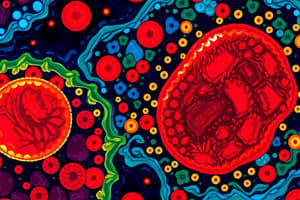Podcast
Questions and Answers
What is the primary function of peroxisomes?
What is the primary function of peroxisomes?
To house many metabolic pathways involved in lipid metabolism.
Which of the following enzymes is involved in the degradation of hydrogen peroxide within peroxisomes?
Which of the following enzymes is involved in the degradation of hydrogen peroxide within peroxisomes?
- Hydrolase
- Peroxidase
- Oxidase
- Catalase (correct)
Peroxisomes contain their own DNA.
Peroxisomes contain their own DNA.
False (B)
What types of organisms possess peroxisomes?
What types of organisms possess peroxisomes?
Which of the following compounds can induce the proliferation of peroxisomes?
Which of the following compounds can induce the proliferation of peroxisomes?
Peroxisomes are involved in the $b$-oxidation of very long chain fatty acids, dicarboxylic acids, and _____ acids.
Peroxisomes are involved in the $b$-oxidation of very long chain fatty acids, dicarboxylic acids, and _____ acids.
What regulates peroxisome volume?
What regulates peroxisome volume?
Flashcards are hidden until you start studying
Study Notes
Overview of Peroxisomes
- Peroxisomes are simple subcellular organelles found in all eukaryotic cells.
- Contain approximately 125 proteins, including 60 enzymes in the matrix and 45 membrane proteins, making them less complex compared to other organelles.
- Named for their metabolic enzymes that generate hydrogen peroxide, which is harmful to cells.
Structure and Function
- Surrounded by a single membrane, peroxisomes vary in diameter from 0.1 to 1 mm.
- Can exist as interconnected tubules known as peroxisome reticulum (e.g., in liver cells) or as individual microperoxisomes (e.g., in fibroblasts).
- Involved in the degradation of hydrogen peroxide via the enzyme catalase, converting it into water and oxygen.
Environmental Responses
- Peroxisome contents adapt according to environmental conditions; for instance, yeasts grown on oleate show increased fatty acid β-oxidation enzymes, while those grown on methanol have elevated alcohol oxidase levels.
- Peroxisome volume regulation involves proteins like Pex11p and Pex25p, and excess peroxisomes are removed via autophagic mechanisms.
Related Structures
- Specialized variants of peroxisomes include glycosomes in parasites (e.g., Trypanosomes) and glyoxysomes in plants.
- Distinct from hydrogenosomes, mitochondria, and chloroplasts.
Functions of Peroxisomes
- Main functions are centered on lipid metabolism, including:
- β-oxidation of very long chain fatty acids and 2-methyl-branched fatty acids.
- Early synthesis of ether glycerolipids (plasmalogens).
- Formation of bile acids and cholesterol.
Distribution and Origins
- Present in all eukaryotes—ranging from unicellular organisms to plants and animals.
- Unlike mitochondria and chloroplasts, peroxisomes lack their own DNA; all proteins are encoded by nuclear genes.
- Proposed to have originated from endosymbionts that gradually lost the ability to reproduce independently.
Studying That Suits You
Use AI to generate personalized quizzes and flashcards to suit your learning preferences.




